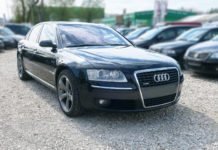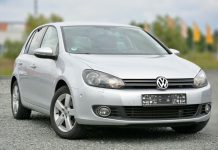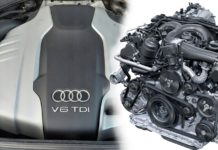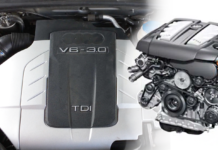With the first generation Audi Q7 you can tow things, transport things, travel long distances comfortably and even go to the forest – for some mushrooms perhaps? Well, you can! Since it has a very good standard 4 wheel drive system and a height adjustable adaptive air suspension – most cars have this feature, but it was optional.
This very first Audi SUV shares the same but slightly modified platform with the 1st gen Porsche Cayenne and 1st gen VW Touareg. But since the Q7 is longer it was available as a 7 seater version too. However unlike the Cayenne or Touareg, the Q7 doesn’t have a low range gearbox neither locking differentials, so except the permanent 4WD and air suspension, it lacks any kind of equipment which is helpful off the road. So going to the forest is a good idea only if the roads are not too “off-road-ish”.
Interior
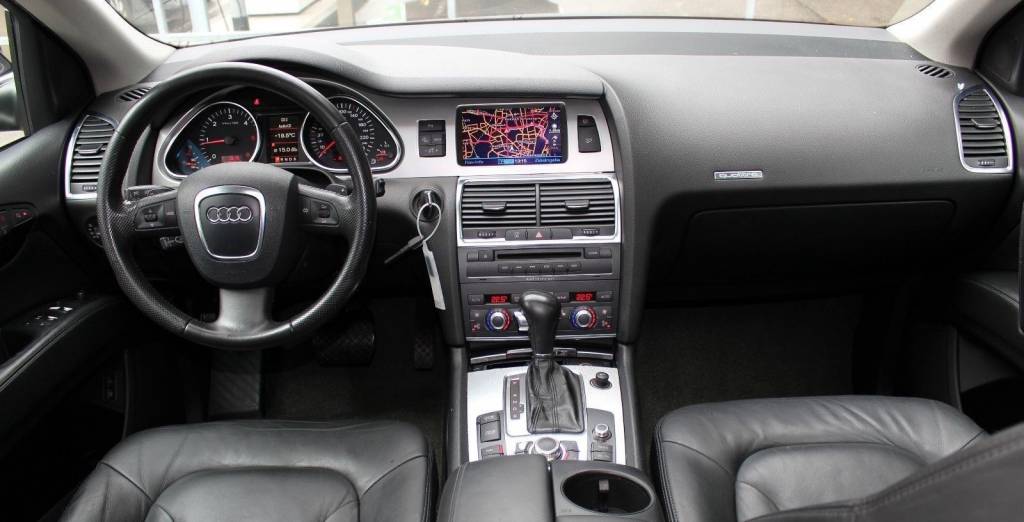
Equipment
The equipment of these cars may vary a lot (the same way as in other German cars).
For example, cars sold in Europe can be sometimes really poorly equipped with only the standard equipment which contains for example a horrible looking standard monochromatic MMI screen, standard manually adjustable fabric seats!, power windows or the… well, and then nothing else basically. On the other side, cars sold in the US for example had much better standard equipment + the optional equipment list was long enough which means, that except some fancy stuff like soft-close doors, night vision, massage seats or the latest modern features the first owner could spec his car with things like:

- navigation system (updated from 2009 after facelift)
- leather seats
- blind spot monitoring system
- adaptive cruise control
- wealthy looking full leather interior-with leather dash, door panels and center console
- alcantara headliner
- rear seat entertainment package (with screens in the front headrests for the rear passengers)
- electrically adjustable steering column
- heated steering wheel
- panoramic sunroof
- keyless entry & start
- double glazed windows
- a good Bose sound system
- a more impressive 14 speaker Bang & Olufsen sound system
- heated and ventilated front seats
- heated rear seats
- 4-zone automatic AC
- and so on…

Build quality & materials
The build quality is overall good and it’s definitely better than in the 1st gen Touareg. However there are some weak spots like the:
- rear seats-which can often make a rattling noise on bad quality roads
- the front center armrest often creaks
- rattling & ticking noises from the panoramic sunroof are common too
All the plastic parts in the interior are fairly durable, but again there are weak spots like:
- the keyless start stop buttons surface can be worn
- the windows switches can be worn (mainly on the drivers side door panel)
- the metallic trim around the shifter often starts “bubbling”
- the back plastic covers of the front seats can get loose – the glue gets weak over time
- sagging headliners starting to be common too – mainly on cars without sunroof
Other stuff
space
The interior with the trunk space is overall really spacious, so the passengers can’t really complain. However I have to mention that the headroom is not that generous like in the 1st gen. Touareg or in a Range Rover L322 + the trunk space also lacks vertical space, so be ready that putting a bit higher stuff in it vertically is gonna be challenging.
visibility
The visibility from the interior is not the best. The side windows are pretty short (compared to the 1st gen. Touareg or Range Rover L322), the visibility to the back is not good and the dash is mounted pretty high. So overall you will feel a bit more like sitting in a tank, mainly compared to the second gen Q7. + there are the very wide frontal A-pillar sections which will hide a lot of things on the road.
(2nd gen.Q7 on the LEFT, 1st gen. Q7 on the RIGHT)

Body, paintjob, rust protection
Body
The body of this Q7 is rigid enough, so you won’t hear much noises of body flexing – UNLESS you drive a car with the panoramic sunroof or a very high mileage car. In these cases you can expect slight noises of body flexing on uneven pavements.
Paintjob
The paintjob on these cars is really durable, so it will look good even after many years and miles – if the previous owner has not neglected the car completely of course.
Rust protection
The rust protection on these cars is on a very good level, so you most probably won’t find cars with a lot of rust or with holes in the body. But there are some weak spots, so:
- rust around the door handles is common
- slight rust on the rear door edges is common too
- check the inside & outside parts of the rear fenders
- check the tailgate for corrosion spots
Possible problems
1. Wiper arm
The first possible issue is related to the front windscreen wipers. Interestingly the passenger side wiper arm can simply break which can be an unpleasant surprise during driving in the rain.
2. Keyless door handles
Then it’s good to check the keyless entry feature if the car is equipped with it. The keyless sensors in the handles and the small black button on them(-which locks the car) can fail. In this case you have to buy a new handle, or you can try to find a used one. But remember that the faulty keyless entry handles can drain the battery!
3. ECU dead as a rock
The engine ECU is located right under the windshield → it’s not protected very well → so the water can drip on it → and eventually leak into it → thus destroying it completely. (facelifted cars should have an additional cover on the ECU fitted from the factory – but to be sure it’s better check it out if it’s really there or not)
a water damaged ECU will cause various funny issues like: engine limp mode/loss of power, check engine light, various fault codes stored, various warning lights on the dash, engine turning off by itself or you won’t be able to start the engine at all
4. Blower motor
The next thing on the list is the blower motor which can simply stop working, but it can also make squeaking/chirping noises. To prolong the lifetime of the motor and to get rid of the noises you can remove it and clean it. But if it’s completely dead then you will have to replace it. The motor is located behind the glove box so replacing it is not very hard + you can save money if you buy a cheaper aftermarket part.
5. AC left the chat
Be ready that on cars used on winter salty roads the metallic AC pipes located inside the front left fender area can simply corrode. In this case a small hole will appear on one of the lines and the AC gas simply leaks out. To top of that, on cars equipped with the 4-zone AC there are additional AC lines which go from the front to the the rear left fender – and yes as you guessed, these additional lines inside the rear left fender area can corrode & leak as well.
6. Tail lights
The before facelift cars can have issues with the regular non-LED taillights. The bulbs in them will often keep burning out or they simply won’t work. To fix this: first try to pull up a bit and clean the bottom contact in the bulb socket → to make a firmer contact with the bottom of the bulb. If this won’t help then most probably you will have to replace the wiring harness.
7. Power tailgate
Check the electronically operated tailgate as well. If it’s not closing properly then most probably the latch on the tailgate or the electronic striker plate mounted on the body will be faulty. The main electric motors near the tailgate hinges are usually fine, but they are not gonna last forever – so over time they will get weaker. If they get weaker they won’t be able to close or open the tailgate correctly. To prolong the lifetime of the motors replace the gas struts in time which will obviously get weaker over time.
The next issue related to the tailgate is the tailgate closing/lamp switch which can fail. This switch is mounted under the middle part of the cargo area edge chrome trim. If it fails you get a tailgate open warning even if it’s closed + instead of the main tailgate lamps – only the small narrow secondary rear lights on bumper are gonna work. switch part number: 4L0959121 video how to replace this switch
8. Rear windscreen wiper motor
You should also check if the rear windscreen wiper and washer system is working properly. Over time the seals inside the rear wiper motor fail → thus letting the washer fluid to leak into the motor itself → which will obviously destroy the motor.
9. Steering lock
The electronic steering lock can fail and in this case you won’t be able to start the car. For more information about this check out this video about this specific issue
10. MMI
2 main causes why the MMI multimedia system stops working:
- Because of the position of the front cup holders there are many cases when owners simply spilled drinks onto the MMI control panel. Because of this the panel can fail and the MMI system stops working. In this case you have to change this control panel or just buy a new circuit board for the panel and replace only the circuit board – which is a much cheaper solution.
- Another common cause why the MMI multimedia system stops working is because of a failed amplifier – which fails because of a well known water leak. So as in the other cars: the water will cause premature death of some of the electronic modules and I don’t think you would like any of that!
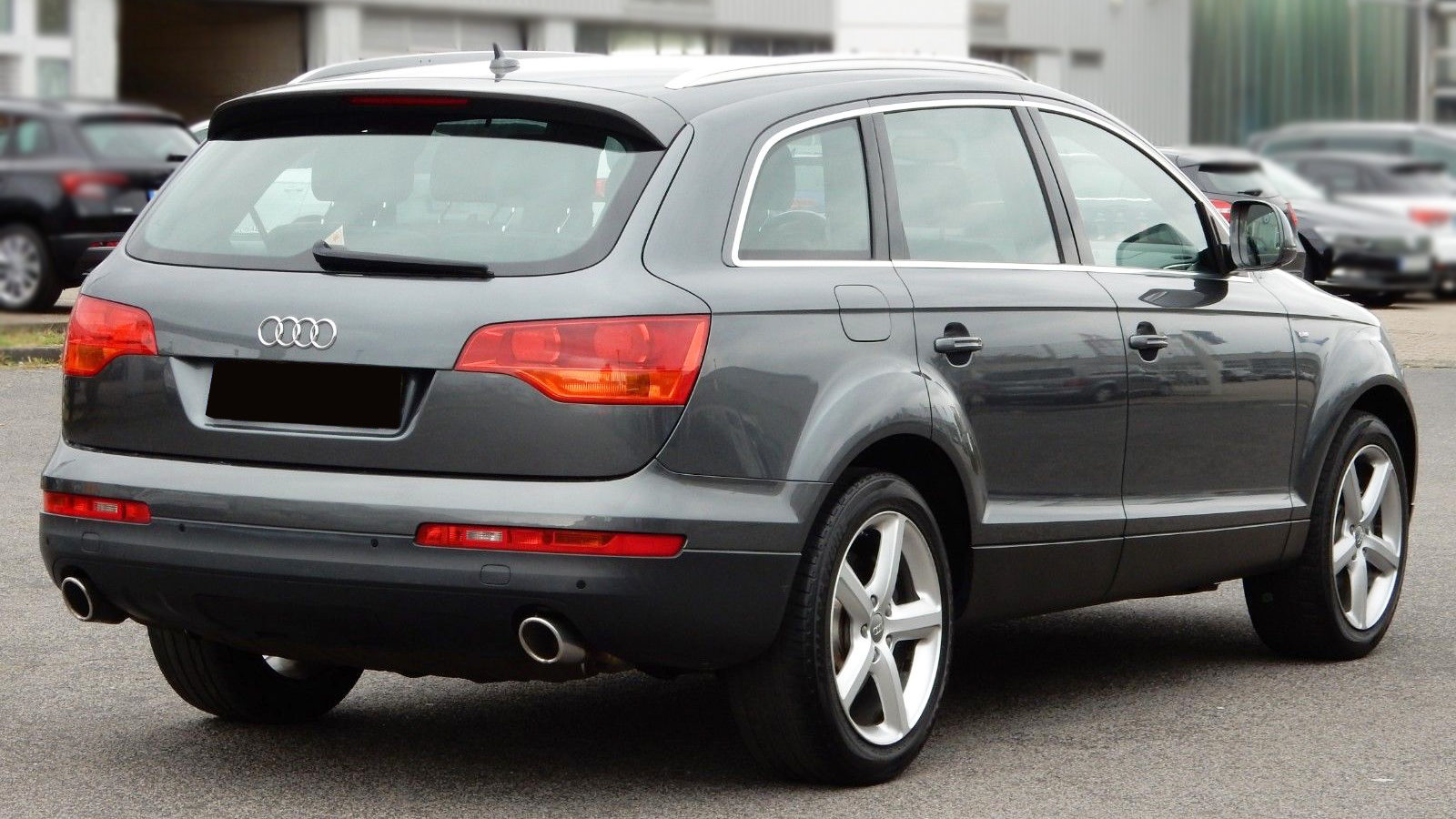
There are basically 3 well known sources of water leaks into the interior:
1. AC evaporator drain hose
The AC evaporator drain hose located under the glove box can sometimes get clogged. In this case the water will leak onto the passenger side carpet. Luckily it’s not hard to clean this drain hose: → just remove the plastic cover under the glove box, slide off the AC evap. rubber tube → clean it with compressed air or with some edge trimmer line → and that’s it.
2. Scuttle / Plenum drains
The next possible source of water leak are the clogged drains under the windshield, causing again – water in the front footwell. Basically, dried out leaves and other shit will accumulate in the scuttle area under the windshield over time. There are 2 rubber drain plugs behind each front wheel well cover on both sides of the car – which drain the water from this scuttle area. Now, these rubber inserts get clogged and this will cause the water to accumulate in the scuttle area → which will eventually leak into the interior. But not only that, since if the water somehow reaches the engine ECU (which is located in this area) then there is a high chance that the water leaks into it and it will destroy it !! So occasionally just remove these rubber plugs and flush the area with water + clean the scuttle area from the upper side to avoid experiencing these issues.
3. Sunroof drains
And the lastly, the most expensive water leak is caused by the infamous sunroof drains:

There are 4 drain tubes in each corner of the big 3 part panoramic sunroof, and they can leak:
- Either because the drain tubes are clogged with dirt which is not a big surprise
- But also because of the upper plastic endings of the drain tubes → which simply get a little loose over time creating a gap around the connection → which allows the water to leak not just into, but also onto the drain hose
The front drain tubes allow the water to collect in the front footwell area and the rear drain tubes allow the water to drip in the trunk spare tire area and most importantly → right onto the amplifier which is located on the right side of the trunk. The failed amp will cause issues with the MMI multimedia system like: no sound, random rebooting, it can drain the battery or the whole system will not work at all.
MMI modules
Keep in mind that all the MMI modules are connected with fiber optics so if one module is completely faulty, then the whole system will not work at all. If you don’t know which module is faulty then you can purchase a fiber optic loop bypass connector which will help you to find the faulty module. But remember, sometimes even two modules can be faulty at the same time so in that case you have to buy more bypass loops.
If you don’t know which module is faulty, then you have to check all the modules by disconnecting each module and connecting the specific module wire to the bypass connector. So for example if your MMI is not working and you connect the amplifier wire to the bypass loop and the MMI starts working but without sound, then the amp is faulty.
And another funny thing – if you want to replace the amplifier for example with a new or used one, then you will have to bring it to the dealer or to someone who is able to code it specifically to your car. But it’s also possible to repair it and in this case there is no need to code it since it’s the same amp.
Also keep in mind that various electronic gremlins can pop up at low battery voltage! + when putting in a new battery – you should do a recalibration/new coding of it via the diagnostic computer, since the battery management system acts differently to a new battery!
But let’s go back to the loose drain connections and how to fix them. First you have to access them by removing some of the parts of the headliner. Then you can fix the connections freestyle basically, so you can put some glue into the gaps or cut off the faulty connection, heat up the drain tube and put the connection inside the drain tube. At the end any fix is better than no fix.

Causes of batter drain

Most common battery drain causes:
- keyless entry door handles
- water damaged amplifier in the trunk (cars equipped with panoramic sunroof)
- water damaged electronic modules in the trunk under the amplifier (cars equipped with panoramic sunroof)
Other possible battery drain causes:
- water damaged MMI control panel
- water damaged/corroded connectors of trunk lock, electronic trunk closing button
- water damaged/corroded trunk exterior license plate bar with illumination and trunk opening switch
- rare cases when a newer MMI software caused battery drain (in this case the MMI doesn’t turn off completely after locking the car) fixed with installing older soft
- cases when owners install aftermarket electronic equipments like: aftermarket alarm, video screens and so on
Suspension

This Q7 was available with the:
- standard coilover suspension
- adaptive air suspension
The standard suspension is fine enough if you don’t want to deal with funny and annoying issues in the future. In this case you can’t adjust the ride height and the stiffness of the shocks-so putting 19 or 20 inch wheels on a car is gonna reduce the ride comfort a lot, unless you are gonna use the car on good quality roads. But all you have to replace at some point are the worn shocks and struts in the future.
The air suspension is indeed a lot more complex, but considering it’s complexity it is still fairly reliable. With this suspension type you can adjust the ride height and the stiffness of the damping. In this case putting 19 or 20 inch wheels on a car is not gonna cause a disaster. However I have to add that even in comfort mode the suspension is not that soft as I would expect. Anyway. If you buy a Q7 with air suspension, then you have to be ready to replace the various parts of it which will fail at some point:
- the air compressor will fail
- the height sensor link rods are gonna seize up and eventually break
- sticking residual pressure valves can occur too causing that one side of the car will be higher or lower (this valve is on top of each air strut and there is special socket for removing this valve – VAG T10158 /1)
- the air struts will leak at some point

In cars equipped with the air suspension you can adjust the ride height and the stiffness of the damping.
Compared to other similar cars there are not that many cases of leaking air struts-because these specific air struts are the most durable air strut type which you can have in a passenger car. However even the highest quality part will fail at some point, so they will obviously start to leak sooner or later mainly because of the age, not because of high mileage. In other words: on cars which are older than 10-15 years I would be definitely ready to replace them because of the leaks.
Other suspension parts
Most of the other suspension parts (control arms, bushings, ball joints, wheel bearings) are durable, but coming to 200 000 km some of them can be worn out. Specifically the front drop links are a weak point of the suspension-worn drop links will cause rattling noises from the front, but they are easy and cheap to replace.
Be ready that because of the big weight the tires and brakes are gonna wear out faster than on smaller cars!
Propshafts
This Q7 is equipped with a front and with a rear propshaft. Both of these parts are fairly durable, but they will wear out over time. Worn propshaft symptoms:
- slight knocking sounds/feel in the interior
- clicking sounds at acceleration/or when releasing gas
- humming noises at constant speed
Also check the propshafts visually under the car. Check mainly the connecting points and the middle section of the rear propshaft for: wear, cracks in the rubber, or traces of escaped grease.
Brakes
This car was available with:
- standard steel brakes
- optional carbon-ceramic brakes
The ceramic brakes are awesome, powerful and they really can withstand a lot – even more than 200 000 km (not racing use). BUT they are not gonna last forever, they can crack and chip and a complete set of brand new genuine ceramic brakes costs more than $20 000. However it is possible to convert these ceramic brakes to conventional steel brakes + if you buy a car with less than 150 000 km which has the brakes in good condition, then you should still have a good amount of life left on the brakes.
on the next page: ENGINES, TRANSMISSIONS




